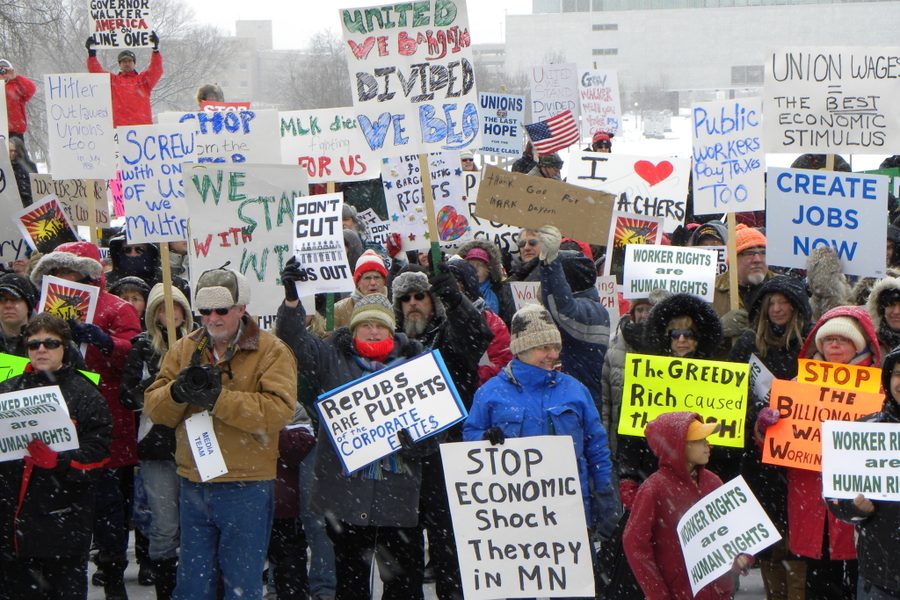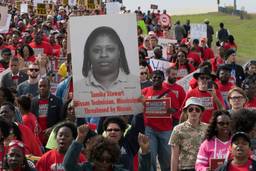
Since last fall, organized labor has urgently focused on defeating George Bush — described by AFL-CIO president John Sweeney as “the worst president we’ve had to deal with.” Even if Kerry should win, the labor movement faces a wrenching debate over its future starting the day after the election.
Despite Sweeney’s reform victory nearly a decade ago, the labor movement has made progress mainly in its political work, not in the crucial task of organizing in a globalized economy where many workers’ jobs are moved out of the country and U.S. workers increasingly face powerful multinational corporations.
The debate after the election will focus on what kinds of changes labor must make to expand its ranks and its power. One key group of labor leaders argues that, much as labor in the ’30s grew when new CIO unions organized according to industries rather than crafts, unions must now create structures to confront industries dominated by a few multinational corporations. To do this, unions must update their approach to organizing members, holding politicians accountable, recruiting public support, and creating the structures needed for solidarity and power.
The challenge was taken up this summer when two aggressive but small unions — UNITE (historically apparel and textile workers) and HERE (hotel and restaurant workers) — merged to form UNITE HERE.
“This merger is about dealing with globalization,” said John Wilhelm, former leader of HERE, who will effectively be a co-president with UNITE’s Bruce Raynor of the merged union.
UNITE has strong finances and talented staff, but a vanishing traditional industry. The apparel and textile unions that much earlier merged into UNITE represented 1 million workers 25 years ago, but UNITE entered the recent merger with only 190,000 workers. Yet UNITE has successfully organized many workers in recent years, including about 40,000 industrial laundry workers and those in apparel distribution and sales.
HERE, with about 250,000 workers, has great opportunities to organize hotels, casinos and food service providers — jobs that are hard to move out of the country. But it lacks resources — especially in the post-9/11 hospitality industry slump. In these domestically anchored industries, the union increasingly confronts not local owners, as in the past, but a small number of large multinational corporations with enormous power.
The merger doesn’t create a union with one easily identifiable sector, but the merger makes sense because it matches resources and opportunities, and both unions have worked extensively with immigrants and workers of color — disproportionately women — in typically low-wage industries. The merger will succeed, Wilhelm argues, if the new union organizes more new members than the two would have separately.
While pledging support to its old apparel and textile base, UNITE HERE will downplay organizing workers exposed to the global market and instead “will organize the jobs that can’t be exported,” Wilhelm says. It will attempt to make the low-wage jobs of the Wal-Martized service economy into solid middle-class jobs, much as unionization historically raised standards for poorly paid manufacturing workers.
Much as UNITE HERE leaders hope that their merger will set an example for other unions, the Service Employees International Union (SEIU), the largest and fastest growing union in the AFL-CIO, hopes to inspire other unions to focus on a few core industries and their dominant employers to build union power. SEIU, which will have 1.8 million members by the year’s end, announced plans this summer to strengthen the union by going global, organizing in regions where it is weak (like the South), creating stronger industrial divisions, and building its community, political and local power. SEIU will launch a virtual, Internet-based arm of the union that opens membership — which SEIU President Andy Stern hopes will hit 1 million — to anyone who wants to support SEIU objectives. In collaboration with UNITE HERE and unions around the world, Stern announced an innovative campaign this summer to organize Sodexho, a French-owned multinational provider of outsourced food, janitorial and other services. Globally Sodexho and two other multinationals, Aramark and Compass, are the dominant “multi-service” corporations, employing 1.1 million workers.
But Stern, Raynor and Wilhelm also have set their sights on transforming the structure of the labor movement, including the AFL-CIO. SEIU and UNITE HERE, along with the Laborers and the Carpenters (which left the AFL-CIO in 2001), linked up last year as the New Unity Partnership (NUP) to support each other in organizing and to promote change in the labor movement. They contend that the 60 unions now in the AFL-CIO should consolidate into 15 to 20 large unions focused on broadly defined industries, unlike the loose federation it currently is, to organize campaigns at major employers on a much grander, even global scale. These NUP leaders emphasize that they are determined to take “the leading role to lead labor out of this wilderness” of recent years, Raynor says. Stern says bluntly, “We need to transform the AFL-CIO or build something new.”
The problem with the AFL-CIO is its structure, not president Sweeney, Stern says, and both Raynor and Wilhelm praised Sweeney for his efforts. Sweeney in turn praised the value of their challenges and dissent and echoed many of their complaints about other unions. While it is still possible that someone, perhaps Wilhelm or Laborers president Terry O’Sullivan could challenge Sweeney for reelection next year, there are signs that NUP leaders could support Sweeny if he is wiling to push hard for reforms, such as enforceable rules on mergers and organizing, many of which he has long advocated.
At next year’s AFL-CIO convention, Stern says he will propose giving the AFL-CIO more authority to “stop bad mergers,” to prevent unions from organizing in areas where other unions have started campaigns or have organized extensively, and to prohibit unions from undercutting each other with substandard contracts. There also must be meaningful penalties for unions that violate such rules, Stern says.
“I would hope [Sweeney] would lead, but that’s a decision he would have to make,” Stern says. “The question is, ‘What does the AFL-CIO believe in enough to fight for?’ This is not a time of consensus. It’s a time for leadership.” It’s also a time, Stern says, to involve union members, not just top leaders, in a debate about the future of the labor movement. If Sweeney or someone else can’t forge a stronger AFL-CIO, the NUP leaders hint that they could turn to other structures. “We are a divided labor movement that talks about unity,” Stern says. “At some point people will do what’s best for their members.” That may start with defeating Bush, but that’s only a start.

I hope you found this article important. Before you leave, I want to ask you to consider supporting our work with a donation. In These Times needs readers like you to help sustain our mission. We don’t depend on—or want—corporate advertising or deep-pocketed billionaires to fund our journalism. We’re supported by you, the reader, so we can focus on covering the issues that matter most to the progressive movement without fear or compromise.
Our work isn’t hidden behind a paywall because of people like you who support our journalism. We want to keep it that way. If you value the work we do and the movements we cover, please consider donating to In These Times.
David Moberg, a former senior editor of In These Times, was on staff with the magazine from when it began publishing in 1976 until his passing in July 2022. Before joining In These Times, he completed his work for a Ph.D. in anthropology at the University of Chicago and worked for Newsweek. He received fellowships from the John D. and Catherine T. MacArthur Foundation and the Nation Institute for research on the new global economy.








